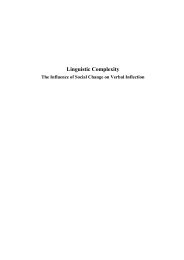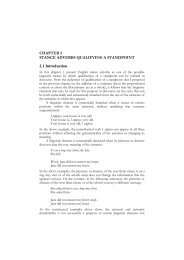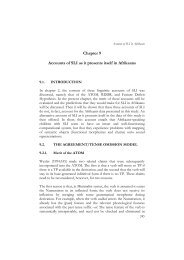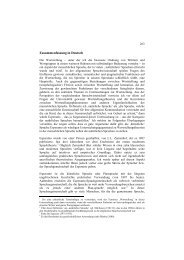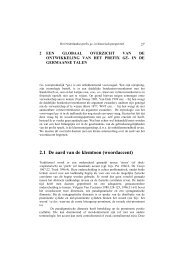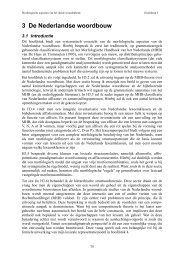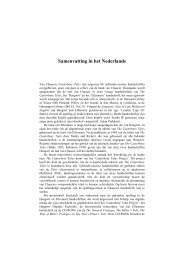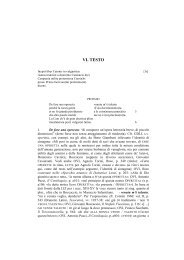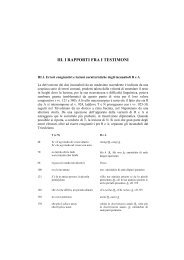Chapter 8: Other Verb-Phrase Operations - LOT publications
Chapter 8: Other Verb-Phrase Operations - LOT publications
Chapter 8: Other Verb-Phrase Operations - LOT publications
You also want an ePaper? Increase the reach of your titles
YUMPU automatically turns print PDFs into web optimized ePapers that Google loves.
204 A Grammar of Mualang<br />
Examples (8-94 and 8-95) show that with adverbs a verb meaning ‘go’ and ‘to be<br />
LOC’ is implied.<br />
b) Prepositional phrases<br />
Various locative and directional phrases with their heading prepositions have been<br />
given in <strong>Chapter</strong> 5. Horizontally, the stream of a particular river is used as a point of<br />
reference against which the location or direction of an entity is established, namely:<br />
ulu ‘upstream’ and ili’ ‘downstream’, e.g. (see also example (8-36) above):<br />
(8-97) Antu Gergasi k=ili’–k=ulu, ka ili’<br />
ghost G to=downstream–to=upstream to downstream<br />
ka ulu N-inaw gu’ kacung ....<br />
to upstream ACT-look.for voice frog<br />
‘The ghost Gergasi went downstream and upstream back and forth<br />
looking for the voice of the frog ....’<br />
(8-98) Dua iku’ .... ti s-iku’ da ili’.<br />
two CLASS REL ONE-CLASS LOC downstream<br />
‘Two (frogs) .... one of them was at the downstream side.’<br />
However, their use has somewhat developed conceptually with ili’ being able to<br />
refer to a direction heading away from the place of origin and ulu heading back to<br />
the place of origin, e.g. ili’ ka Jakarta ari Mualang ‘head to Jakarta away from the<br />
Mualang area’.<br />
Parts of an entity (notably body parts) are used also as specification of a location<br />
or direction relative to a certain point of orientation, which may be implied or<br />
overtly expressed, e.g. ataw ‘upper part, top’ and baruh ‘bottom, lower part’, mua<br />
‘face, front part’, belakang ‘back, back part’, kiba’ ‘left(handed)’, kanan<br />
‘right(handed)’, etc. These words have to be combined with a locational or<br />
directional preposition. For some examples, the reader is referred to section 5.3 of<br />
<strong>Chapter</strong> 5.<br />
c) Serial verb constructions<br />
A general discussion of serial verbs will be given in <strong>Chapter</strong> 10. One of their<br />
functions is to combine the notion of direction with other activities or events. Some<br />
motion verbs occupying the second verb position add such meanings to the<br />
preceding verb. Turun ‘descend’ and tiki’ ‘ascend’ usually indicate movement in a<br />
vertical direction, whereas verbs like pulay ‘go home’, datay ‘come’, rari ‘run<br />
(away)’ imply a horizontal one, e.g.: rari turun (run-descend) ‘run down’, bay’<br />
tiki’/pulay/rari (bring ascend/go.home/run.away) ‘bring up/back/away’.



